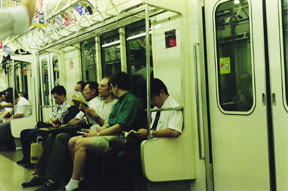
|
Sunday 8/16- REALIZING THE 38-HOUR DAY The flight was snug, but thrilling as we flew out over the Aleutian islands. We were headed 8000 miles from home. Jen had joined her family in visiting her uncle, heading security in Tokyo when she was fourteen. I had never even seen the Pacific ocean, let alone crossed it. When we landed, Narita airport came easily to us- it seems the universality of airports is, in fact, an international phenomenon. We were to take a bus to downtown Tokyo, an hour and a half to the south, to meet Rob Clingan. The three of us had gone to Wooster together. Now, Rob was studying traditional Noh theatre in Tokyo for a year on a Fulbright scholarship. When he offered to put us up for two weeks, we knew we couldn't afford to go. We also realized, more importantly, that we couldn't afford not to go, and planned out first real vacation in two years. We e-mailed him- "We'll be the Three Musketeers!" He was excited, but replied: "More like the Three Stooges!" I should have slept on the plane as Jen did, but was too excited, and too busy adjusting to the notion that Japanese men smoke more incessantly than most Americans. Two rows behind us. During the movie "Mr. Magoo." So it was that I was divided emotionally on our bus ride, the body trying to sleep, but thwarted by the mind. Everything around me was new. The cars were several model years ahead of their American counterparts. They were also driving on the left side of the road. Vegetation along the highway was entirely unfamiliar. Moreover, it was hot and drenchingly humid. Jen looked at me: "Welcome to Southeast Asia!" Rob was living with Richard Emmert. Rick is an ex-patriot, living well in Tokyo for over thirty years. His townhouse is enormous by local standards. Tokyo is an enormous city, even by American standards. It's population is literally twice that of New York, with 15 million people sprawled out over the flood plains. It keeps real estate expensive, though, and Rick has three floors to himself. This month, however, Rob had it to himself as Rick toured, bringing multi-cultural theatre to the States. We finally arrived at dinnertime, and went to one of the many local, family-owned restaurants for traditional cuisine of soba noodles and miso soup. Rob also gave us his room for the stay, a traditional Japanese-style room replete with thick, basket-like tatami mats for a floor, and thin futons to sleep on. He had given us the traditional welcome as well, with flowers in the vase and tickets to several theatre events laid out next to pamphlets- in English- with information about the city on his low kotatsu table. We slept well that night, as Rob glowered: "This is the longest day you've ever had!" But it was to be the shortest on our trip. Monday 8/17- TOKYO AND THE IMPERIAL GARDENS As his work at the university would not begin until September as did mine, Rob had cleared his schedule for us. We began to explore the city around us. The culture is older than American culture by a couple of millennia. I was apprehensive about all the mistakes I would make. Rob wrote before we left: "Yes, Japan is very different from America, but there are frighteningly many similarities. So don't expect a completely 'alien' experience. Just plan on relaxing and having a good time. I was uptight far too long. It ruined my first month. Learn from my mistake." I was still uptight. |
 |
In a city not contained, as is the island of Manhattan, Tokyo is somewhat disorganized to American eyes. The neighborhood streets are much smaller than ours, with room for only a single car and perhaps a pedestrian across their width. Parking, of course, is a premium, and one must prove access to a space when purchasing a vehicle. Many Japanese travel by bicycle or moped, and walking must be done with care. The public |
| transportation, though reputedly complex, is very thorough.
There are two complete train systems covering the city- a subway system,
and a network of local Japan Rail lines. We had shrewdly bought JR passes
for the two weeks, knowing we would be traveling. Rob's student visa, alas,
would not allow us to buy him one, but we made room on the charge cards.
After growing up mastering New York's complex subway system, I scoffed at
the naysayers, and we set off downtown to charge Rob's ticket for our journey
the next week to Kyoto.
First lesson: Japan is a safe city. People are more courteous than I could have imagined. Basic street theft is almost unheard-of. One peculiar side-effect of this is that the credit card is not quite as powerful there. As people feel free to carry a lot of yen around with them, Tokyo is a "cash and carry" town. Which, of course, scuttled our Financial Plan A. Plan B, however (spend all of the cash at the JR office and run like crazy to the bank to convert all the travelers' cheques), worked fine. We were also traveling just after the Yen crashed. As Jen signed her name repeatedly at the bank, I shrugged. "Japan is on sale." I had asked Jen before we left what the focus of the trip might be. In a word, she summed: "Shrines." It turned out to be true. Most of Japan's landmarks are tied in with the sacred, from the homes of great leaders to the breathlessly radiant gardens. Our first day- after the nice lady at the bank gave us some more money- was spent at Meiji Imperial Gardens. Shrines in Japan are marked with a Torii. The structure, formed to look like an ancient bird perch, is a gateway to the divine, representative of purification. The Meiji Imperial Gardens are marked by the largest Torii in Japan, towering above the wide path, a symbol of affluence in itself. The gardens were not the diligently organized flower boxes of France nor the aesthetically pleasing jumble of British gardens, but something of a cultivated woods, with trees, paths and ponds forming a very tranquil place. The central pond was stocked with fat, happy carp. The were happy because they are considered sacred, and never disturbed. They are fat because everyone seems to throw crackers at them, including the only other western couple in the park that afternoon. Unlike Western Europe, where most tourists seem to be American or German- or, indeed, Japanese- Tokyo is truly an international city. This couple was Australian. Of course, there home was probably closer to Japan than ours... The afternoon was spent across the road, finding lunch in an bustling alley of shops, selling everything from the latest pop minidisc to T-shirts with the kanji character for "saki" on them. Many American items seemed popular here, though English phrases were sometimes grammatically negotiable ("Punk not dead!") and the brothers hanging out at the Nike store were speaking Japanese. There, we also found the "Oriental Bazaar," clearly catering to foreigners, but doing it with style. Rob was showing me a Noh mask on a wall to demonstrate how small the eye holes were. A saleswoman interjected: "Not real mask!" We knew it was a modern souvenir, but it was unexpectedly honest of her to say so, even without our asking. In Nogales, Mexico, I had bargained with a salesman on a bracelet for Jen. He insisted that it was a real jewel stone inset. Of course it was not, and he knew that I knew it, but the claim was part of the ritual. On the contrary, honesty prevails in Japan. I knew then I would never be cheated here, and I believe I never was.
Tuesday 8/18- GINZA AND THE KABUKI-ZA |
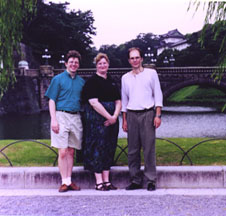 At the Imperial Palace
At the Imperial Palace
|
Tired from the touring and the jet-lag, we took the morning off, and had a leisurely breakfast with green tea and toast with "peanut-o cream," a sweet, buttery variation on peanut butter. Thus fortified, the stooges headed for a quick turn at the Imperial Gardens East, and the home of the current emperor. The bridge across the extensive moats was flanked by guards as still as Buckingham's Beefeaters. Around the moats and along the major (read: wider) downtown avenues, muscular joggers contrasted the ancient style of the Imperial residence. We entered the gardens and climbed up to the walls of the old fortress, past elegant tea |
|
houses, to the ramparts. The original castle had burned with much of Tokyo under the American bombs of World War II. Rob, after a decade of living in Italy where landmarks like the La Scala opera house had succumbed to the American air fleet, had grown accustomed to blasting our politics of the 40's. Jen, a history major grew up accustomed to voicing her opinion, especially as a lone woman in male-dominated Wooster history classes. Their discussion had become quite heated when I realized all at once that we were guests in Tokyo, a scant half-century after we had burned it down. Humbly, I pulled them off of the tower. The afternoon brought us to Ginza, named after a center of the silver market, now an upscale shipping district and home to the Sony building, a showcase of their newest technology. Of course, I went bananas- the idea of throwing on a pair of video goggles hooked into a portable DVD player and watching "Godzilla" on the subway was almost too much. Wide-screen, digital, high definition televisions, DVD, flat screens, video goggles and minidisc technology abounded. Jen, who puts on a brave front of resistance, was worse than I was. Somehow, we made it out the door with only a new portable CD player, though I kept trying to figure a way I could sneak a pair of those goggles into my luggage without her noticing. |
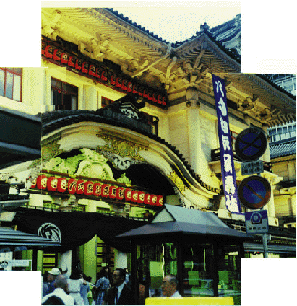 |
We had tickets that evening nearby to the national Kabuki-za theatre. In a city of 15 millions, we bumped into a friend of Rob's there, another westerner studying Noh. The theatre was equipped with a wireless translation system, which made the wild performance all the more enjoyable. Kabuki seems to take a given idea and expand it to show the most possible action. It is very exaggerated. Two musicians sit at the left of a very wide proscenium stage. The actors are dressed in fantastical makeup, and frequently stop the action for a series of grotesque faces. The audience cheers, calling out the actors' names. We saw treachery, murder, revenge, backflips and, during intermission while the audience ate their bento box dinners, a display of fabulous stage curtains. The troop- often an extended family- |
| performs three shows daily for a month straight
before touring to another theatre. We saw two acts of a single play, through
the dramas are written in such a way that each act is complete enough to
perform individually. The form also seemed surprisingly young to me; many
of the plays were written in the 18th century.
When we emerged, Ginza was lit for the evening, a dazzling display of diverse neon. But we hadn't seen anything yet. |
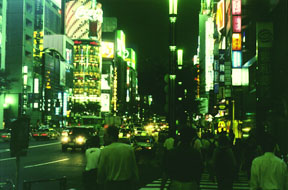 Lights
of Ginza Lights
of Ginza |
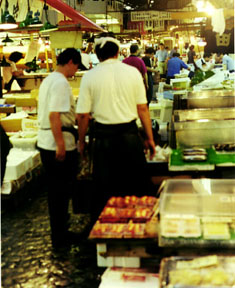 Skiji
Market Skiji
Market |
Our jet-lag was still working for us, and it wasn't too hard to get up early for Jen this day. She wanted to take me to Skiji, a Japanese experience one couldn't have anywhere else. She was quite right. Skiji is the fish market. It is no tourist spot; it's the center of commerce for countless fish stalls apparently organized in tight grids in some proportion to the streets of the city. It was this third morning that I came to understand that we were truly gai-jin, western foreigners. As Jen and I left Rob to sleep in and wandered around the wet, concrete floors of the immense market, I saw many heads turn to stare, amazed at the Big Blond White Chick. I think it was our camera, slung over my shoulder, that brought them the most amusement. The fish was clearly not like those from the Atlantic, which I had |
| seen too often in Maryland. They had salmon here as large
as I am, thick enough to require a table saw to cut. Most of the wares ranged
from fresh to flipping and, while a bit unnerved, I was certainly impressed.
And hungry. We dodged the ubiquitous forklifts and explored the pandemonium
for a while, and headed out to the street for breakfast. There were many
stalls, but only one with "wax food," artistically skillful representations
of their menu. The owner spoke little English, but happily made us soba
noodles. When she later brought a fork to the place, Jen gently reminded
me that this was not an insult, but yet another example of Japanese courtesy-
they wanted us to be comfortable.
In exchange for me indulgence in the early hour, Jen indulged me and we set off for Akihabura, the electronics district. Here there were dozens of small electronic shops, each offering you the "best-o price" on all manner of items. Again, though, there was no haggling here- all shops were actually offering you a price at a slim margin above their cost. The sales people were also low-pressure, making it much more attractive to me. Jen, thank goodness, had a great sense of humor when we found the same CD player we'd bought for ¥3000 less. We did manage to get away without buying a new VCR- something her family had not succeeded in her last time over- but did get a portable DAT for me for school for half the price we would have back home. We finally arrived back at Shinjuko, running late to meet Rob, but proud to find each other in the massive train station. There was no time to return to meet back at the house as planned. Jen ran off and found me a razor (electric: no one uses anything but), and I made myself as presentable as possible. Rob had arranged a rare and special treat for me. His Noh sensai agreed to let me sit in on Rob's private training session. Though Rob wore jeans himself, it is an honor for him to study under a very accomplished performer: I didn't The complex was outside a gymnasium, and the ancient sounds of chanting mingled with the cries of schoolchildren. Many of Rob's colleagues there are young debutantes, who consider the ancient art a part of their cultural training, much like ballet and riding are viewed by many Americans. Rob wore "very white" split-toe socks, and worked on a floor designed to amplify the stamping so integral to Noh. The training itself is imitation of the traditional dances and chants. The latter are written down in books, but these are only used as a reminder of the text. The chant itself must be memorized through much repetition. Rob's sensai has an enormous and impressive voice, though is not presumptuous about the ancient art. He was marking his schedule book as he corrected Rob's chanting. The lesson itself gave me much to consider in the art of solo training: I hope to borrow the refinements when I begin to teach composition in private lessons. We began and ended with a cup of tea. There was time built in to the lesson for personal conversation: one's mentor seems to keep track of his pupil's whole life, as the whole life is reflected in Noh. He was very kind to me and made me feel entirely welcome. I sat bolt upright the entire time, looking as respectful as I could. Probably looked terrified. Living constantly with the enticing smell of brilliantly cooked dumplings must be a trial for Rick. When we returned, we succumbed to dinner in that family-owned restaurant just next door to the house. They had our place set almost as we opened their door. Thursday 8/20- NIKKO |
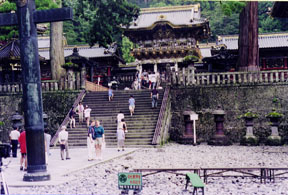 |
Our first side trip was up to
Nikko, home to some of the most famous- and most ornate- temples in Japan.
It is also very dense with shrines, each more lavish than the next. We enter
these performing a Shinto ceremony of cleansing. Stopping at the fountain
outside, we raise a ladle and pour water over our left hand, then right,
then cleanse the mouth.
The Rinno-ji acts as a gate to the complex of Shrines, and houses three magnificent statues. To |
|
reinforce their presence, you approach them from below- they sit on a base about seven feet high. Along with the Daikoku and Bishamon, who bring fortune, is a statue of Benten, patroness of music and the arts. I felt extremely humble. Inside, a courtyard featuring the famous monkeys representing "see no evil, hear no evil, speak no evil." Actually, they are one of a series of friezes, adorning the stall of a white sacred horse. Is there a message here? Another temple teaches the history of its treasures by a lecture in Japanese, also involving Shinto worship and prayer, which always begins with summoning the Deity with a clapping of hands twice. I feel suddenly the universality of worship here. I do not understand one word spoken in twenty minutes, yet the power of the faith is present. There are many differences in Eastern and Western faith- but now they seem unimportant. Rob leans over at one point with a respectful, though impish smile: "you know you're supporting a pagan faith by spending money here. Very Bohemian." He's right- but the power of the worship itself is overwhelming. And suddenly Western religious bias seems laughably petty. |
| The celebration of family is important here. One shrine is oriented for children, with ring toss games we take a turn at. There are many wonders in the shrines and temples that fascinate the children of Japan and the world. In one, a dragon is engraved in the ceiling. If you make a sharp sound directly under the dragon's mouth, the sound erupts in reverberation much like a metal plate. But there is no metal in the temple. The | 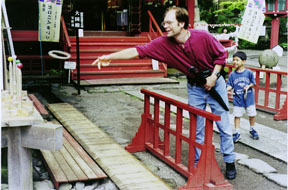 |
| dragon, as they explain, is roaring.
There is a hierarchy to the shrines. A prince's tomb lies past the Tosho-gu, a famous symbol of a sleeping Cat, and up steep flights of stairs, in a landing surrounded by the forest. It reminded me of my own Adirondack mountains. Spirits are everywhere. A nearby tree's trunk is stuck full of coins- a spirit lives in the hollow of the tree. The Shogun who built this shrine has a memorial of his own, with a series of gates. Set into the gates are brightly colored carvings of demons to protect the shrine in red, green, blue and gold. The shrine at the top is structured like an I. We stand in the lower crossbeam and look through the vertical, down a passageway, at the chamber laden with treasures. It is kept dim, and Shinto gold is not shiny, but left dull and awesome. We cannot see all of the treasures, leaving a powerful effect. This place, like Stonehenge or Canterbury, is filled with music for me- a MM7 chord with a deep accelerating drum beneath. The silence is deafening. |
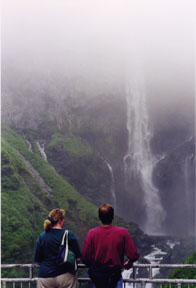
|
In the afternoon, we take a
bus to Chuzenji-ko, to see the breathtaking Urami-no-taki waterfall. The
bus' ascent is itself a terrifying spin up steep switchbacks. The parking
lot at the top is apparently managed by wild monkeys, who tease the tourists
or food. At the falls, we find them entirely fogged in, but are promised
a view at a platform halfway down. We are not disappointed. Here is the
consummate image of Japan, water in mist, one barely distinguishable from
the other. Time stood entirely still there, as the mist shot past us. Jen
was even more enraptured than I, and gazed into the hypnotic cascade as
though she would never leave. The Japanese, who value nature as intensely
as the marketing of it, had set up a souvenir stand on the observation platform.
We hardly noticed it.
For the evening, we hiked back around Lake Chuzenji. it was a longer walk than it seemed. |
| We stopped in a souvenir shop and tea parlor, where they promptly offered us coffee, throwing in some peanut crackers when we explained we hadn't had dinner yet. The owners were a family with three young children, playing with an adorable small terrier. As amused as we were by the dog, the kids were clearly amused by the tourists. It's still nice to know that laughter transcends language. The hike was well worth it- the temple itself was closed, but nearby benches on the shore faced the lake, shrouded in a magical mist, with momentary glances of the mountains and town occasionally peeking back at us. The three kids and the dog frolicked by as the sun began to set. Older cultures are often associated with tales of ancient magic. Japan has more than old tales. |
 |
|